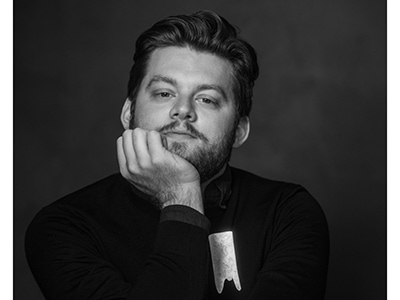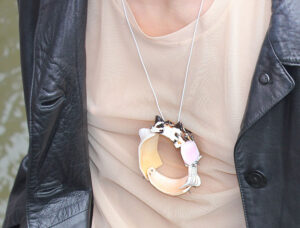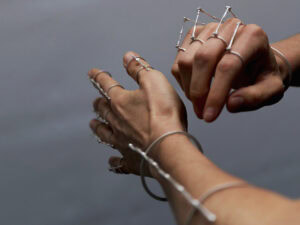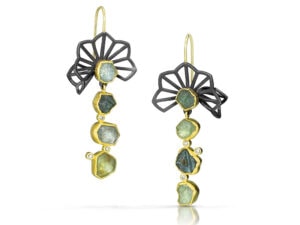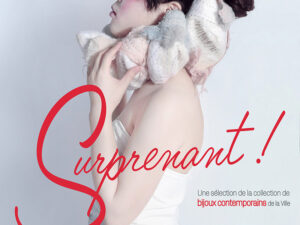You’re an artist. Imagine waking up. It’s early morning. You get out of bed, set two feet on the ground. Make coffee, pour yourself a cup. You walk to the studio, turn the lights on with clicks of switches: Your space is active now. You sit down and make—paint portraits of people, collect images of objects, make something that is intrinsically about the “self.” Why do you choose this, why do you choose that?

Since artists have been alive, the image of self in both the reflection of an individual life and the outward observation of the world in which they live has never lost its power. Toiling away in solitary studios, they reflect both inward and outward, preserving images, places, and faces that are present. It isn’t just narrative, nor merely an act of recording, which determines this making. It’s something else. Looking at a survey of contemporary jewelers and object makers in the field, I ask this question: What impulse leads contemporary makers to create around notions of the “self” and of the times in which they are making?
We see portraits every day, and everywhere. The world is saturated in images and platforms for images, with people snapping shots of their surroundings, selfies, and simply what they had for dinner. But what does it mean to be an artist in that world? For this essay I asked several artists a series of questions regarding portraiture in jewelry, using the above prompt to frame it. Sparked by reflecting on the work I relate to, this essay is not a “how to” nor a “this is what portraiture in jewelry is.” I hope the reader following the meandering anecdotes below will instead draw contrasts and similarities woven together in topics such as Image-Making, Purpose, Place, and People.
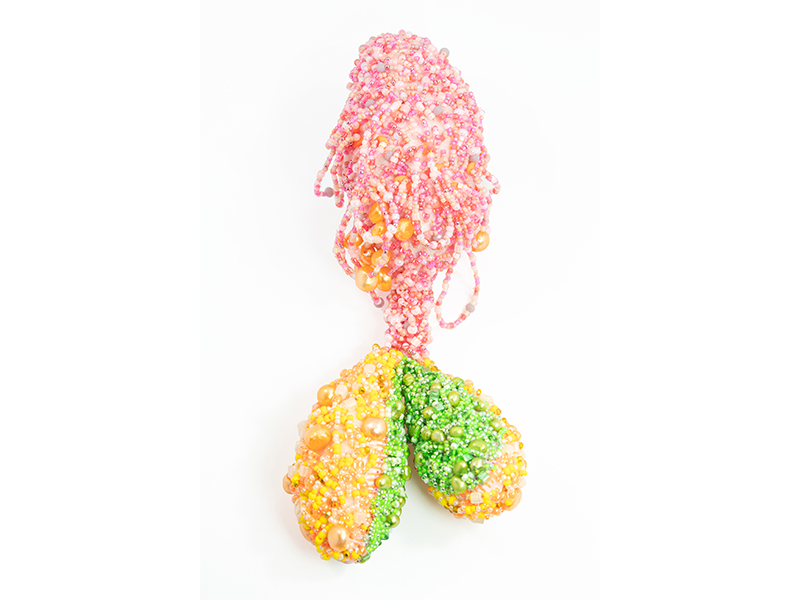
Image-Making
What does it mean to “make images”? I asked this question to artists, privately wondering whether one could break from portraiture as “representation” to think abstractly, and in an imaginary space. Breana Ferrara is a younger jeweler whose work is characterized by beaded and plushy forms so cute they border on the grotesque. In speaking to this notion, Ferrara says,
I have always loved portraits that show the weirder or more taboo bodies, lives, and experiences. … you will never catch me drawing or painting or any other form of literal “image-making,” through observation at least. I love fantasy and the strange, I’ve always loved imagining the possibilities of the paranormal, and so most of my image-making, at least if we are talking about my jewelry itself being the image, are all images from my brain that usually don’t have a lot of basis in literal reality, maybe in another plane of existence, but not this reality. However, our world is usually stranger than anything in fantasy or conspiracy or the paranormal, so I guess my image-making, even in its fantastical or unrealistic qualities, still refers to our world and experiences.

The jewelry stands in contrast to “our” reality, framing the paranormal, the weird, the strange, and the fantastical with ordinary beads, pink plushy forms, and polymer clay. Instead of the usual “places” we associate with portraiture (such as hills, mountains, backdrops), Ferrara offers us beaded cornucopias representative of a queered reality filled with bulging-eyed animals and puffy pillows of painfully pink protrusions. It may be difficult to see this as any kind of portrait, but much like the classic narrative portraits and paintings filled with objects, jewelry, rich fabrics, and people standing in front of hilly European backgrounds, Ferrara’s pieces are assemblages of signifiers rooted in the artist’s psyche—even more, the materials chosen represent the artist, who in no way appears “represented” in any of their jewelry.
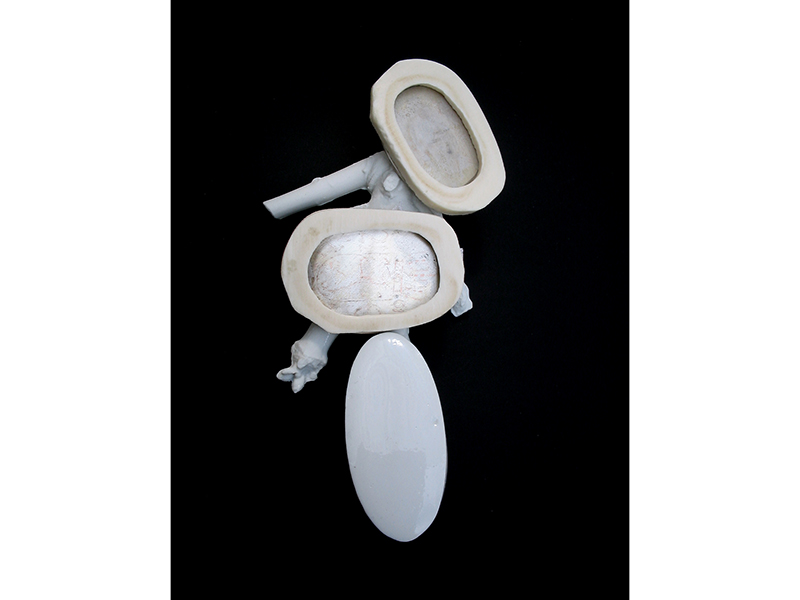
Does the presence of one thing we don’t expect make it more palpable of the thing we long for? This idea of presence through absence arose in conversation with Iris Eichenberg about Weiß, a body of her work that shares few visual connections to Ferrara’s, but conceptually could be kin. In these works, one sees many ovals, a shape associated with Eichenberg’s work, but all blank, made from porcelain and silver. When describing the work, Eichenberg described how the oval, without figures inside, transcends our ability to “place who” we see and only projects the sensation of “what we don’t see.” Going further, she describes her degree work from the Rietveld Akademie as image-making and portraiture, the only works she has ever titled Portraits. Pieces of knitted yarn, hearts stacked, “these pieces were based on what you couldn’t see when looking at someone,” she said, “the things that are right underneath the skin.” These pieces were of course not portraits, nor human anatomy. They instead “recalled the notions, and evoked the sensations, images, and feelings of both.”
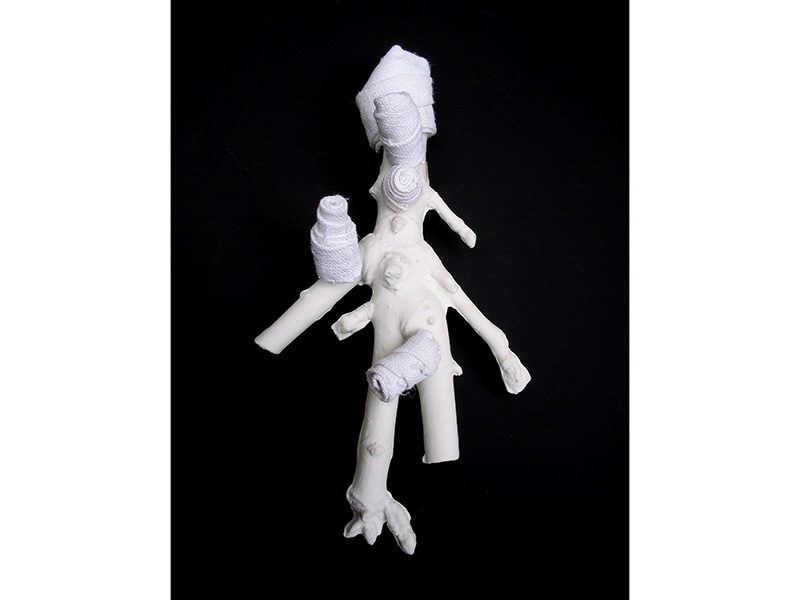
Purpose
Whenever I ask a group of people what “something” means to them, I immediately feel like I’m conducting an ice breaker at a “professional practice” conference, and the answers will be either too surface, too polite, or too … typical. The answers I got for this question of portraits were none of those things.

Hansel Tai, an artist trained in Estonia, learned “from a very early stage in life that portraits have incredible powers.” He goes on to say, “Images can be shocking, erotic, nostalgic, and even life changing. In a way portraits always need to reflect those hidden corners of the society we live in.” One knows this from looking at his work. Pierced pieces of jade, cut-out collages of colorful mirrored acrylic seemingly drip off his models’ faces—nods and stylizations of queer culture based around the phallus and ejaculations.
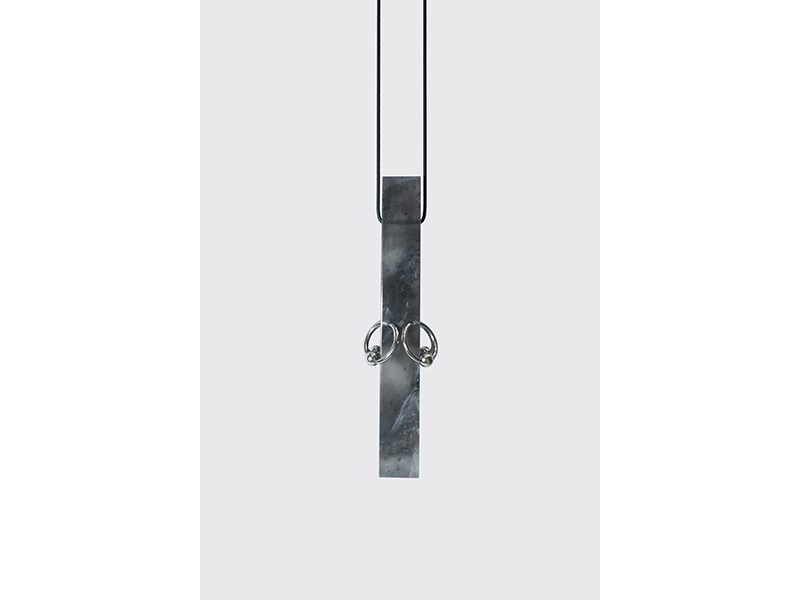
In speaking to his images, Tai states, “We don’t need to add more narratives to a singular vision manifested by cross-continental super corporation; we need different, alternative narratives, we need diversities, we need to be guided by different futures.”
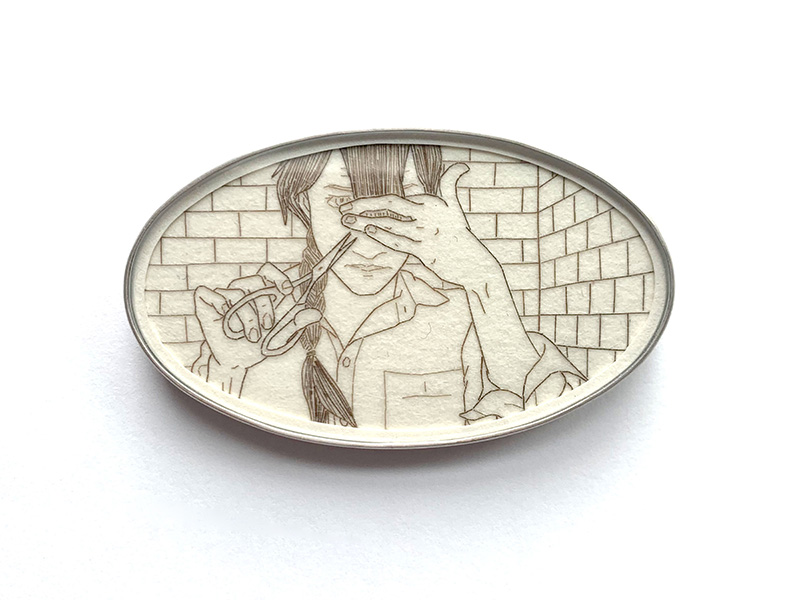
Melanie Bilenker is an American artist known widely for her use of hair in jewelry that depicts scenes, moments, and images she captures from her daily life. In speaking to the purpose, and service, that portraits position themselves for, Bilenker gives a concrete read, noting,
Portraits are meant to depict an individual as they are or as they wish to be seen. The manner of representation, as well as the setting, costume, and tone, affect how they are viewed.
In much the same way that jewelry can reveal one’s identity via: allegiance to a group (political badges to pearls to punk), hierarchy (costume jewelry to crown jewels), or relationally (memento mori to miniatures of loved ones)… so does portraiture itself. The depicted may be portrayed in the costume of a group, the setting or garb of hierarchy, or as a memorialized individual—living or deceased.
The latter (emotional, relational, memorial) is of the most interest to me. I am drawn to the interplay of anonymity vs. the personal. I collect portraits of people I’ve never met. These people were important to someone, it is easy to see that and to identify with their humanity. Most people who have and wear my work do not know me personally, yet there is connection. There is connection in the commonplace, to recognize yourself in others, to identify yourself with others.
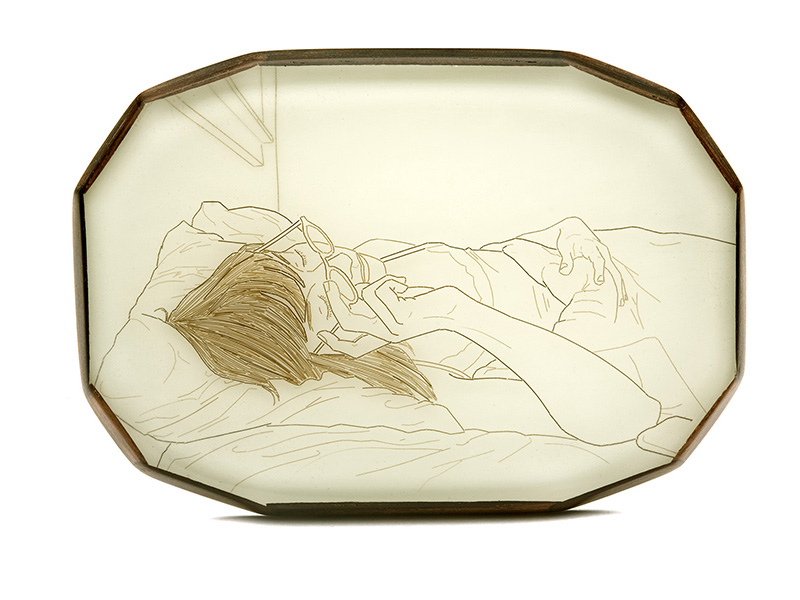
Bilenker’s work references mourning jewelry, in which hair was used as a main element in jewels that served as a remembrance of deceased loved ones. Jewelry from the Victorian period carried a strong aesthetic language of jet, braided hair, pearls, and portraits. One could imagine that with such strong source material, Bilenker’s jewelry could easily become a visual quote of Victorian jewelry, using the associated materials and aesthetic, and, in turn, border on the anachronistic—but instead, Bilenker fashions hair in a novel way, capturing scenes of her routine domestic life, rooting the pieces in the “now” by illustrating cooking with Kitchenaid mixers and talking on her iPhone in bed. “Throughout the past many years I have created self-portraits depicting my interior life,” states Bilenker. “While I am representing one individual in particular (typically myself or, on occasion a commissioned individual), my aim is to conjure common life in a universally relatable way.”

Place
In asking about portraits, I repeatedly came across the concept of a timestamp—a dated record, settled in time, and also, in some way, characterized place. When speaking to ideas of depiction, of recording, and of image making, people were important, sure. But, surprisingly, place was as well. In the case of my many conversations with the artists, place wasn’t only location, but also tied to stages in one’s life, such as childhood or adulthood.

Esther Knobel is one of the best-known Israeli artists in our field, producing work with a deeply personal sensibility—some may say sad, but really it’s human. Her work meanders its way through these stages, taking departures in objects associated with time, with process, and with childhood and nostalgia at times. She states,
The search for the domain of childhood is a search for the authentic, the innocent, the archetypical… In order for a work of mine to sprout wings, I must address my constant need to begin from this primal point of departure. This is a form of childishness, but not one that dwells on infantility or nostalgia; instead, it represents a return to the primal experience of a sense of magic.
Knobel’s work is not taking memories from the “domain” of childhood as a fulcrum for purpose. It instead sources the sensations, the air, and the atmosphere associated with the archetypes of childhood, of innocence and play. Knobel’s jewelry addresses a stage in the human condition – specific and universal.
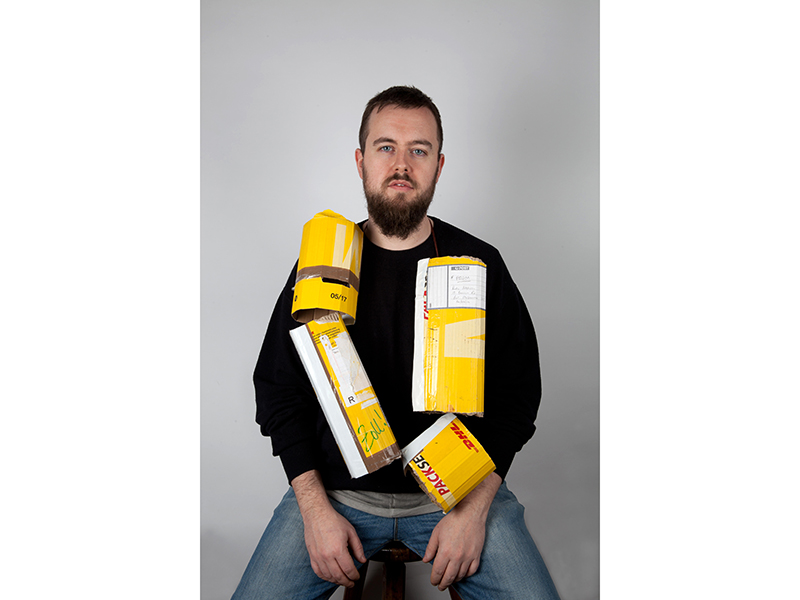
The specifics of our surroundings and upbringings influence us aesthetically, culturally, and likely in ways we may never really know. In moving to new places, we attain a certain objectivity and more keenly see where we come from. The objects, people, and places all gain fresh meaning, or, at the very least, the new vantage point allows us new eyes with which to see. This was clear in several artists’ statements on the notion of place. Paul Adie, a jeweler based in Munich who’s about to graduate from the academy there, spoke to this very idea. In regard to place as location both culturally and physically, Adie notes,
I am a Scottish artist from a working-class background. The so-called UK has a repressive class system in place, with the queen on top, upper classes, middle classes “above” me. Accent and where you were born is a strong indicator of social class in the UK, and people have a lot of preconceptions about you if you speak with an accent. However, through education and work, I have gone far beyond the boundaries I was born into—this annoys people and I love it. My work certainly carries a lot of this “fuckoffedness.” Repression and expectations from society, family, friends, acquaintances have formed me; however, now is the time for me to decide what/who I am. My work guides me through this.
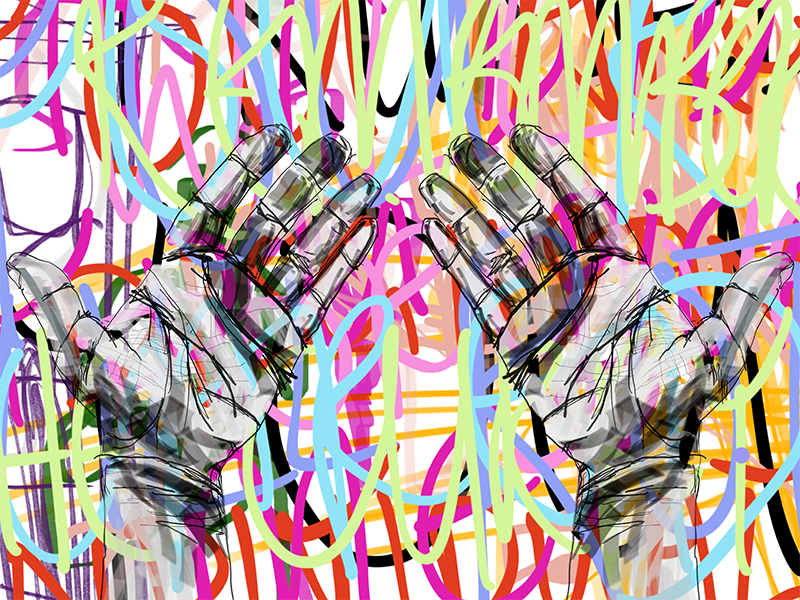
In Adie’s statement, place, person, and culture are inextricably linked—this shows through in his work. The jewelry jars us because of its messy quality. About his sexuality, Adie notes, “I am a queer man aged 35 and still working on how I feel about my sexuality, existence, and being. As a teenager and 20-er I pushed myself to an extreme of gayness, as this was what was expected of me when I came out, but my own current identity is much softer, sensitive, and more fluid.” In looking at Adie’s work, one can immediately see the “fuckoffedness” that roots itself in displaying sexuality, words, and images in a messy, free-wheeling manner. Gestures in carved aluminum, paint from fingertip outlines, words like “dick,” “no,” and “cunt”—it’s all almost too much for the world of art jewelry to stomach.

People
Nearly every artist I spoke with for this essay confirmed that people were central to their understanding of portraiture. Notably, though, several artists spoke about the manner in which people are depicted—posture, the way a person holds their hands, their identity or lack thereof. Eichenberg states that images of people “are made from [the point of view of] an onlooker, there is always an ‘other’ who is looking, recording, and seeing the person being depicted,”—and, even more importantly—“a portrait always has three people: the person looking, the person in the portrait, and the person who the portrait is of.” What the onlooker sees, or is made to see, is paramount to the building of our relationship with the subject.
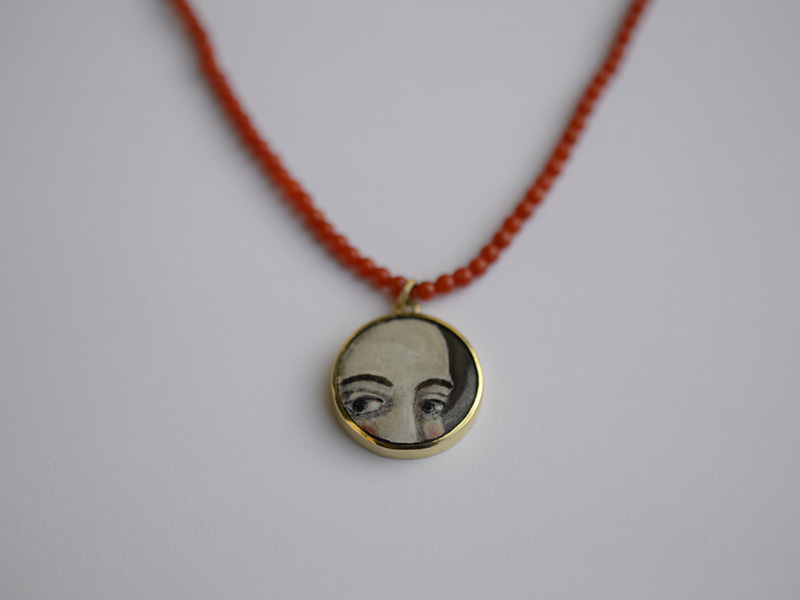
The nature of an artist’s work is relating to others—this is especially prominent in jewelry. Jutta Klingebiel’s work is characterized by vignettes captured in enamel of people, objects, and animals. In regard to her work she states, “Immediately the point of documentation comes to my mind. For example when I paint animals—rabbits, cats, cows, a bird—it is preceded by an observation or an experience.”

Here Klingebiel describes the moments the work comes from as direct interactions, moments occuring between herself and the world. On the presence of people, she goes on to say,
The depiction of a person can be fascinating in various ways. Spontaneously I think it is interesting (and somehow mysterious) to see the portrait as a counterpart, a kind of a silent observer. Maybe, if the picture is painted well enough, you think it is alive. I enjoy creating portraits. Again no sketches, no preliminary drawing, [in order to] to leave enough space for intuition and magic. The creative process while painting and firing the enamel (it is fired many times ’til I am satisfied) is always different, and surprising. But not least when finally a pair of eyes looks at you and the picture “breathes life,” it is always a special moment, and a little bit weird sometimes, too. A glance has a special power. This must be something archaic, neurological, something that is deeply rooted in the human being.
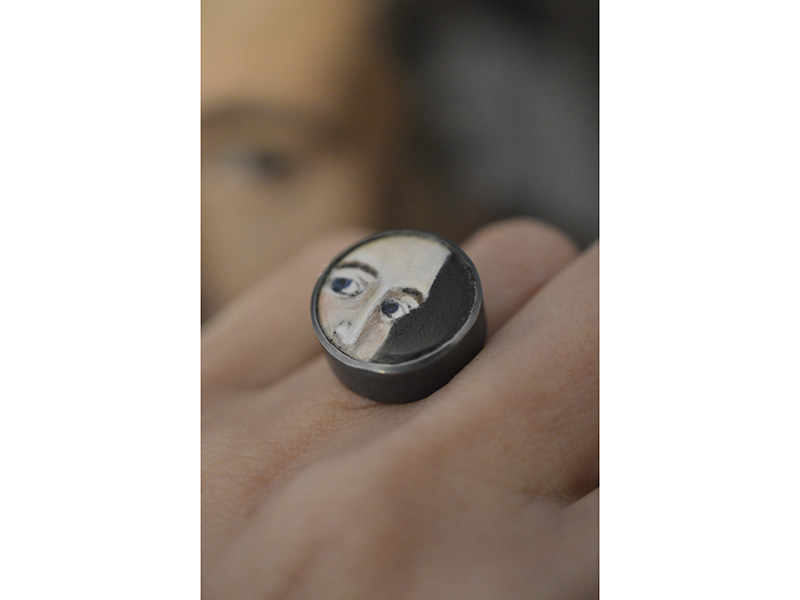
Klingebiel’s painterly approach, sitting for hours painstakingly applying layer after layer of enamel onto her small canvases, evokes a romantic notion of image-making associated with portraits. But she makes a striking observation: The eyes on the face bring her subjects to life. Looking at her works, one senses an idiosyncrasy in gesture, especially in her depictions of eyes, animals, and portraits where the figure is based in realism, but affected by her medium, enamel. Her strokes of paint bring us into a representation of her subject bathed in the artist’s mind, hands, and medium.
In contrast, Eichenberg sees the absence of a face as an opening for projection in which viewers can interpret and sense their way to the people within the frame. At one point in our conversation, Eichenberg asked, “If you were standing in a field, and out in the distance stood your love, you cannot see their face. But, as they start walking towards you, what would you notice?” She went on. “You would see their posture, the way they hold themselves, and their rhythm in the way they walk. People are not just faces, they are physical beings in this world tied to their bodies, the language of their movement is embedded in your memories, and your associations with them.” In a piece from her series Heimat, people sit around a table, only outlines of their bodies pierced by tiny holes, letting light through. Here, the people aren’t depictions, but representations for us to emote with and project onto.
